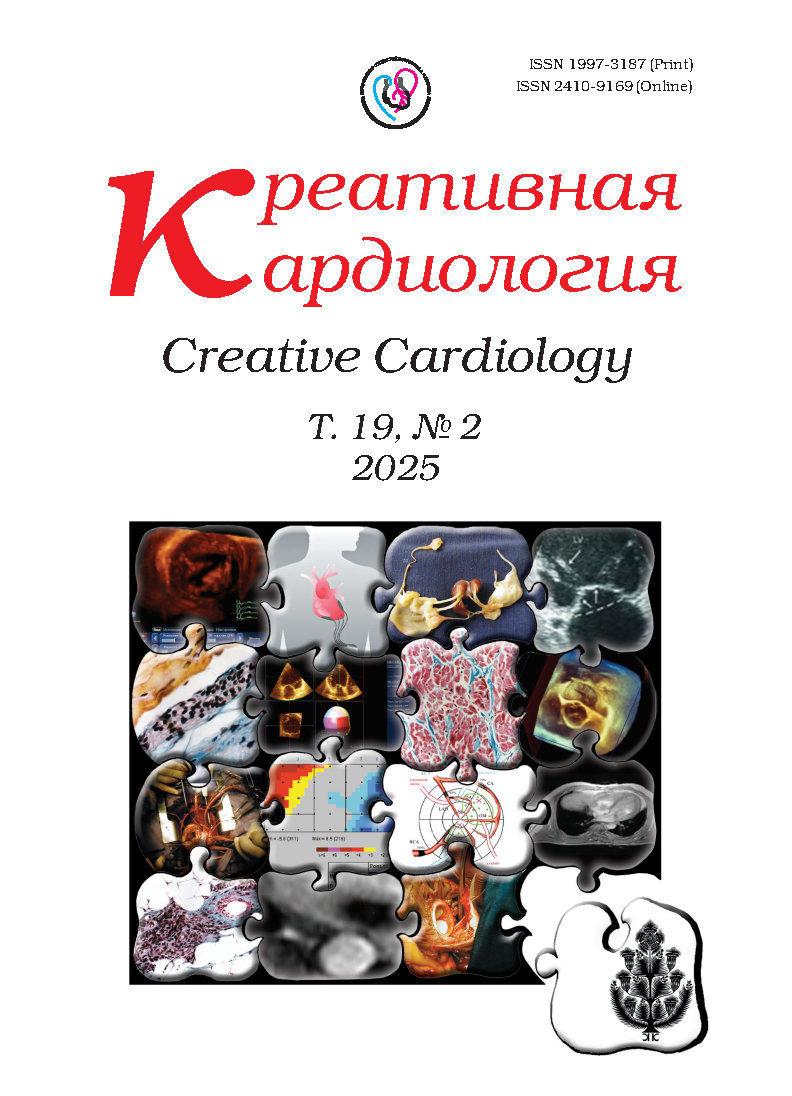Cardiomyopathy in a patient with Duchenne dystrophy
Abstract
Progressive Duchenne muscular dystrophy is a genetic disease with an incidence rate of 1:5000 in males. It occurs as a result of a mutation in the Duchenne muscular dystrophy gene, responsible for the synthesis of the dystrophin protein, which is most often localized in skeletal muscles and myocardium. Cardiological manifestations of this disease include progressive hypertrophic and dilated cardiomyopathy, as well as various arrhythmias that can lead to death. Echocardiography and electrocardiography are used as diagnostic methods for cardiac manifestations of progressive Duchenne muscular dystrophy; fewer sensitive methods include determining the level of creatine phosphokinase, troponin I and other laboratory parameters. Our work describes a clinical case of a patient with a confirmed diagnosis of progressive Duchenne dystrophy and diagnosed cardiomyopathy at the age of 15 years. The disease is progressive in nature with an unfavorable prognosis.
References
Клинические рекомендации МЗ РФ. Прогрессирующая мышечная дистрофия Дюшенна. Прогрессирующая мышечная дистрофия Беккера, 2023. https://dmd-russia.ru/wp-content/uploads/2023/12/klinicheskie_rekomendatsii.pdf (Дата обращения 12.02.2025).
Petrof B.J., Shrager J.B., Stedman H.H., Kelly A.M., Sweeney H.L. Dystrophin protects the sarcolemma from stresses developed during muscle contraction. Proc. Natl. Acad. Sci. USA. 1993; 90 (8): 3710–3714. DOI: 10.1073/pnas.90.8.3710
Wallace G.Q., McNally E.M. Mechanisms of muscle degeneration, regeneration, and repair in the muscular dystrophies. Annu Rev. Physiol. 2009; 71: 37–57. DOI: 10.1146/annurev.physiol.010908.163216
Kamdar F., Garry D.J. Dystrophin-deficient cardiomyopathy. J. Am. Coll. Cardiol. 2016; 67: 2533–2546.
Aartsma-Rus A., Van Deutekom J.C., Fokkema I.F., Van Ommen G.J., Den Dunnen J.T. Entries in the Leiden Duchenne muscular dystrophy mutation database: an overview of mutation types and paradoxical cases that confirm the reading-frame rule. Muscle Nerve. 2006; 34 (2): 135–144. DOI: 10.1002/mus.20586
Magri F., Govoni A., D’Angelo M.G., Del Bo R., Ghezzi S., Sandra G. et al. Genotype and phenotype characterization in a large dystrophinopathic cohort with extended follow-up. J. Neurol. 2011; 258 (9): 1610–1623. DOI: 10.1007/s00415-011-5979-z
Гайнетдинова Д.Д., Новоселова А.А. Современные возможности диагностики и лечения мышечной дистрофии Дюшенна. Казанский медицинский журнал. 2020; 101 (4): 530–537. DOI: 10.17816/KMJ2020-530
Грознова О.С., Руденская Г.Е., Адян Т.А., Харламов Д.А. Поражение сердца при наследственных нервно-мышечных заболеваниях у детей. Российский вестник перинатологии и педиатрии. 2014; 59 (2): 35–42.
Ervasti J.M., Ohlendieck K., Kahl S.D., Gaver M.G., Campbell K.P. Deficiency of a glycoprotein component of the dystrophin complex in dystrophic muscle. Nature. 1990; 345 (6273): 315–319. DOI: 10.1038/345315a0
Franco A. Jr, Lansman J.B. Calcium entry through stretch-inactivated ion channels in mdx myotubes. Nature. 1990; 344 (6267): 670–673. DOI: 10.1038/344670a0
Gandhi S., Sweeney H.L., Hart C.C., Han R., Perry C.G.R. Cardiomyopathy in Duchenne muscular dystrophy and the potential for mitochondrial therapeutics to improve treatment response. Cells. 2024; 13 (14): 1168. DOI: 10.3390/cells13141168
Spurney C., Shimizu R., Morgenroth L.P., Kolski H., Gordish-Dressman H., Clemens P.R.; CINRG Investigators. Cooperative International Neuromuscular Research Group Duchenne Natural History Study demonstrates insufficient diagnosis and treatment of cardiomyopathy in Duchenne muscular dystrophy. Muscle Nerve. 2014; 50 (2): 250–256. DOI: 10.1002/mus.24163
Giatrakos N., Kinali M., Stephens D., Dawson D., Muntoni F., Nihoyannopoulos P. Cardiac tissue velocities and strain rate in the early detection of myocardial dysfunction of asymptomatic boys with Duchenne’s muscular dystrophy: relationship to clinical outcome. Heart. 2006; 92 (6): 840–842. DOI: 10.1136/hrt.2005.067710
Tang L., Shao S., Wang C. Electrocardiographic features of children with Duchenne muscular dystrophy. Orphanet. J. Rare Dis. 2022; 17: 320. DOI: 10.1186/s13023-022-02473-9
Zhou J., Wang Ch. Electrocardiographic features of children with Duchenne muscular dystrophy and genotype analysis. J. Precis. Med. 2018; 33 (04): 300–303.
Shah A.M., Jefferies J.L., Rossano J.W., Decker J.A., Cannon B.C., Kim J.J. Electrocardiographic abnormalities and arrhythmias are strongly associated with the development of cardiomyopathy in muscular dystrophy. Heart Rhythm. 2010; 7 (10): 1484–1488. DOI: 10.1016/j.hrthm.2010.06.022
Connuck D.M., Sleeper L.A., Colan S.D., Cox G.F., Towbin J.A., Lowe A.M. et al. Characteristics and outcomes of cardiomyopathy in children with Duchenne or Becker muscular dystrophy: a comparative study from the Pediatric Cardiomyopathy Registry. Am. Heart J. 2008; 155: 998–1005.
Rose E.A., Gelijns A.C., Moskowitz A.J., Heitjan D.F., Stevenson L.W., Dembitsky W. et al. Long-term use of a left ventricular assist device. N. Engl. J. Med. 2001; 345: 1435–1443.
Дубинин М.В., Старинец В.С., Челядинникова Ю.А., Белослудцева Н.В., Михеева И.Б., Пенкина Д.К. и др. Влияние активатора калиевых каналов с большой проводимостью, зависящих от кальция NS1619, на функцию митохондрий сердца у мышей с дефицитом дистрофина. Биохимия (Моск.). 2023; 88 (2): 189–201. DOI: 10.1134/S0006297923020037
Nigro G., Comi L.I., Limongelli F.M., Giugliano M.A., Politano L., Petretta V. et al. Prospective study of X-linked progressive muscular dystrophy in Campania. Muscle Nerve. 1983; 6 (4): 253–262. DOI: 10.1002/mus.880060403
Боева О.И., Щеглова Е.В., Булгакова Н.Е., Ягода А.В. Случай дилатационной кардиомиопатии у больного с наследственным заболеванием – прогрессирующей мышечной дистрофией Дюшенна–Беккера. Медицинский вестник Северного Кавказа. 2013; 8 (1): 104–108.
Greiner E., Ikeda N., Ryan T.D., Villa C.R. Hypertrophic cardiomyopathy in Duchenne muscular dystrophy: a case series. Cardiol. Young. 2024; 34 (10): 2272–2274. DOI: 10.1017/S1047951124026659

